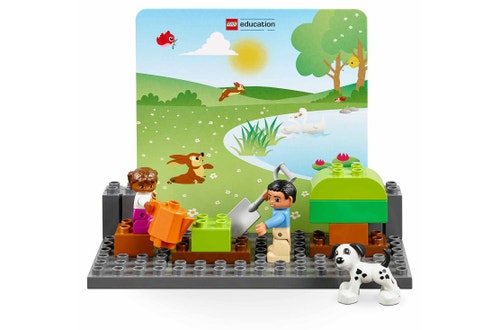Little Seed
Be able to express thoughts, ideas and opinions.

Prepare
Review this lesson plan and choose what you need from the Teacher Support box.
If necessary, pre-teach these related vocabulary words: seed, plant, flower, legume, fruit, vegetable, grow, water, sun.
Consider the abilities and backgrounds of all your students and decide when and how to introduce and differentiate lesson content, activities, or concepts.
If the background cards are missing or broken, you can download them from the Additional Resources section of the Teacher Support box.
Connect
- Show the students the image of the scene of the girl with a watering can (see the activity card below) and tell them that this scene is about people planting a seed.

Ask the students to name some things that are needed to plant a seed (e.g., shovel, watering can, fertilizer, etc.).
Ask them what should be done first when planting a seed. Then ask what should be done next, and so on.
Act out planting imaginary seeds as a group. Ask the students to retell the steps as they act them out.
Discuss what seeds need in order to grow into plants. Have students act like seeds growing into plants.
Construct
Tell the students to build a scene showing what happens to a seed that receives everything it needs.
Remind the students to pick a background card that is appropriate for their story.
Contemplate
When the students have finished building, encourage them to take turns sharing
their scenes and telling a story about the seed.Ask the students to role-play how people took care of their seed to make it grow.
Consider asking questions like:
- What happened to the seed?
- What kind of a plant or flower did the seed become? Did it produce a fruit, vegetable, or legume?
- What did the characters do in the scene?
Continue
Talk with the students about gardens. Ask them to describe a garden and what it needs to grow.
Ask them to combine their plant models or build new models to create a garden.
Encourage the students to use figures to role-play taking care of the garden.
Did you notice?
- Ask guiding questions to elicit students’ thinking and their decisions while ideating.
Observation Checklist
Review the learning objectives and educational standards addressed in this lesson (Teacher Support box).
Share specific student responses and behaviors at different levels of mastery.
Use the following checklist to observe students’ progress:
- Students are able to express their thoughts, ideas, and opinions to others.
- Students are able to describe things and events.
- Students are able to, with prompting and support, provide additional detail.
Teacher Support
Students will:
- Learn about steps in a process
- Describe a sequence
For up to 6 students.
CCSS.ELA-LITERACY.SL.K.4 Describe familiar people, places, things, and events and, with prompting and support, provide additional detail.